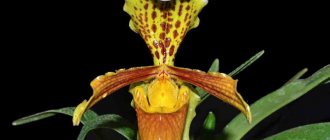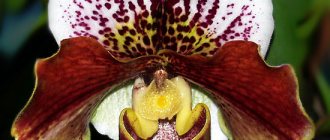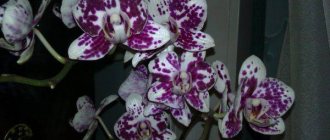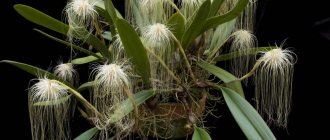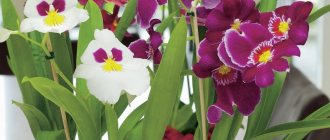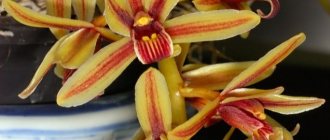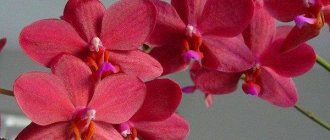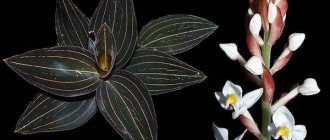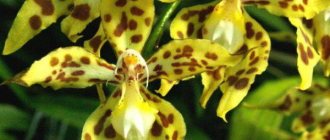A very popular variety of Orchids in Eurasia is the Lady's Slipper (Paphiopedilum), some call it the shaggy orchid (Paphiopedilum naivata). What conditions does this plant prefer? In nature, the Lady's Slipper loves moisture, but not swampy soils.
Moderate light will also be an advantage. As for home conditions, Paphiopedilum is placed in a well-ventilated place , where a sufficient amount of light enters.
Let's take a closer look and find out what the Lady's Slipper orchid (Paphiopedilum) looks like - photo and description of the variety in this article.
Description
A distinctive feature of such an orchid is its flowers , which are shaped very much like a woman’s slipper, which is why they are sometimes called Slipper orchids. The bright colors also attract orchid lovers.
The most common plants are marbled white, light yellow and ash pink.
Less commonly – brown, green and purple. What attracts attention is not the color of the flowers, but the small inclusions on each of them , which can also be of different colors. We must not forget that one rosette forms one peduncle. You can see what the Paphiopedilum shoe orchid looks like in the photo below.
The Lady's Slipper orchid has unusually bright flowers.
It is impossible to resist such beauty; it seems that the plants are from another planet. Previously, all slipper orchids belonged to the genus Cypripedium, and then it was divided into 4 more :
- Cypripedium;
- Paphiopedilum;
- Phragmipedium;
- And selenipedum.
However, when translated into Russian, all four varieties mean the same thing - Venus's slippers .
As for Paphiopedilums, they interbreed well with each other, within the genus. As a result, we have more than 1000 hybrids. Usually the height of the flower is no less than 15 and no more than 25 cm, a distinctive feature is a creeping rhizome.
The Lady's slipper orchid is considered to be a kind of “outcast”. Main habitats :
- Far East;
- Crimea;
- Caucasus;
- Western Siberia;
- and the European part of Russia.
The flower avoids direct sunlight, therefore it grows in shady, warm and dry forests; sometimes you can find the flower on the outskirts of swamps.
IMPORTANT! Some species of Paphiopedilum are able to survive severe cold.
Experienced flower growers say that in order to determine the correct principles of care, you need to obtain information about the original genus from which the acquired hybrid originated.
And if with Phalaenopsis hybrids everything is quite simple, caring for them is absolutely the same, then the Lady’s Slipper requires special treatment.
It is very difficult to determine 100% of the origin of a flower, but for successful flowering it is strictly necessary .
This is the only way to create the most favorable conditions.
Main types and varieties of plants
Miltonia orchid: options for replanting and caring for a flower at home
Not all of the species of lady's slipper found and described centuries ago can be found in nature today. Many of them were lost, but others were successfully cultivated and are now grown at home.
Types of lady's slipper that are often found both in nature and in floriculture:
Real
The lady's slipper, called the real one, can be found in forests and swamps or in the flower beds of folk healers. It is believed that the juices of this plant can cure many mental illnesses and migraines. You can distinguish the species by the color of the flower - a bright yellow basket with brown outer petals.
A real lady's slipper
Paphiopedilum Maudiae
One of the popular hybrids among gardeners. The peduncle is low with one large flower and a neat rosette of dark green leaves. The color of Maudi's shoe is lush green and white; you can see specks inside the bud and light veins on the leaves.
Note! A similar hybrid with a bright speckled bud is American paphiopedilum.
Paphiopedilum Maudi has an unusual white-green color.
Paphiopedilum Delenatii
This is a plant with oblong fleshy green leaves, peduncles up to 40 cm high, at the ends of which 1-3 large flowers bloom. The petals are painted milky, the shoe itself is pale lilac with a dark burgundy or purple lip. During flowering, the Paphiopedilum Delenati orchid emits a pleasant sweet aroma.
Delenati's slipper has a very delicate color
Large-flowered
This type of lady's slipper rightfully bears this name, since its flowers can reach a diameter of up to 10 cm. Their color, depending on the variety, varies from pink to dark red, as well as white. Only one flower blooms on a short stalk - a bright spot among the dark green striped leaves of the plant.
Large-flowered “slippers” look especially bright against the backdrop of green forest vegetation
Paphiopedilum Rothschildianum
Another large-flowered species of orchid slippers, the diameter of the flowers reaches 30-45 cm. Up to four inflorescences can bloom simultaneously on one peduncle. Their color varies from yellow-green to cream, the upper petals have bright purple stripes, the lower ones are covered with a yellow-red gradient.
The lateral striped petals of a pointed shape, spread out like the wings of an exotic insect, give the flower an interesting appearance.
Note! Rothschild's lady's slipper is an extremely rare plant that blooms for the first time only after 15 years. It is impossible to purchase it for a home garden, only illegally for a lot of money.
Exotic Paphiopedilum Rothschild
The Paphiopedilum class includes many more species, hybrids and varieties. Progressive technologies have made it possible to develop the most unpretentious ones in home care and often bloom. They can be found on the shelves of flower shops. In the wild, you cannot dig up a lady's slipper; it is illegal.
Orchids with sympodial growth form
The sympoidal shape implies growth in a horizontal direction .
The next season they give new, lateral growth. Pseudobulbs live for about 2-3 years, after which they turn yellow and die. When the pseudobulb reaches its peak of maturity , its upper bud falls off or becomes an inflorescence.
The growth of the pseudobulb ends with the end of the formation of the peduncle , a new sprout is formed at its base and the next annual development cycle begins.
It is quite rare to find such a sympodial type of orchid, in which the arrow shoots out from a bud located at the base of the shoot or at the top of the flower. The leaves of such orchids are quite thin and narrow.
It is this type that needs lower temperatures during the period of flowering stimulation It is also recommended to reduce watering; over the next 8 weeks, the orchid will feed on the moisture that the pseudobulbs have stored.
In order to stimulate the flowering of the Lady's Slipper orchid, you need to lower the temperature in the room.
This type of orchid can be found in nature in areas where heavy rains prevail , which periodically give way to dryness. Such climatic conditions are typical for the tropics.
Of course, it is quite difficult to ensure such periods at home, so rather unpretentious Venus's slippers were developed .
IMPORTANT! Almost all Paphiopedilums sold in flower shops are hybrids that require moderate temperatures and can easily do without a serious dormant period. To grow them, the natural temperature changes that occur with changing seasons are sufficient.
Popular varieties for indoor growing with photos
Gratrixianum
The most common species among amateur gardeners. It is considered a rather whimsical variety, but when optimal conditions are created and regular care is provided, it grows actively and produces buds profusely during the flowering period. A decrease in temperature is easily tolerated.
The front side of the petals is glossy, and the back has a light fluff. The side petals and lips are shiny, waxy in texture and honey-colored.
Malaysian Gold, Rothschild or Kinabalu Gold
In nature, it blooms only after 15 years of development. The leaf blades are rich green, fleshy and glossy. Up to 6 buds are formed on the peduncle (its length is 0.5 m). The average flower size is 15 cm, but there are specimens whose flower diameter reaches 35 cm.
Vietnamese
Tubers of this variety are easy to find in Vietnamese markets. The diameter of the flower is 10 cm, the shade of the petals is coffee or lilac, the lip is always a contrasting color.
Apricot
The flowers are deep yellow, almost orange inside. White species are rare. The leaves are bright, eye-catching, their length is 15 cm.
Snow-white
A miniature variety, reaching only 26 cm in height. With active growth, it forms several leaf rosettes at once, from which leaf plates 15 cm in length grow.
The foliage is bright green above and covered with burgundy spots below. Usually no more than 2 snow-white flowers are formed on the peduncle, in the center of which there is light crimson pollen. Flower growers say that caring for this species is moderately difficult.
Lawrence
Up to 6 leaves grow in one rosette (their width is up to 7 cm and their length is no more than 20 cm). The peduncles grow up to 30 cm in length, are burgundy in color, slightly pubescent, and only one flower grows on them. The maximum diameter of the flower is 13 cm. The sail is white and pink striped, triangular in shape.
Appleton
It grows naturally in Vietnam, Thailand and China. The best place for them is the shade of large trees. The average flower diameter is 10 cm. The petals are lilac-green, the buds bloom in the spring.
How an orchid grows in natural conditions photo: features of growth
Black Jack
The color of the petals is monochromatic, but very bright. The structure of the petals is waxy, glossy, the diameter of one flower is 8 cm. The sail is round in shape with a pointed tip. The side petals have wavy edges. The leaves are small - up to 15 cm in length, dark green, their upper part is covered with a marble pattern.
Delophyllum
Miniature hybrid variety. The leaf blades are oval-shaped, small. The leaf pattern is marbled, but blurred. The peduncle is pubescent, short, no more than 2 flowers bloom on it. The shade of the sails varies from cream to pale olive. The plant is easy to care for.
Which one is better for a beginner?
It is better for beginners to give preference to paphiopedilum species. There are a lot of hybrid varieties, but breeders provide little information about proper care. It is recommended to get acquainted with the culture with the Gratrixianum and Bellatum varieties.
Reviews
Marina. “I first purchased a Lady’s Shoe about five years ago. The only problem we had to face was leaf burn. Therefore, I strongly recommend that everyone protect their plant from direct sunlight, they are detrimental to this plant variety. Paphiopedilums are incredibly beautiful plants that transform any room with their presence and delight guests. They are also suitable for beginners, as the care features are very easy to understand. I recommend!"
Anna. “I can’t imagine my home without orchids. All the window sills are installed, but I want more and more. I recently purchased a Lady’s slipper – an incredibly beautiful flower. If you properly provide the plant with everything it needs: moisture, light, temperature, then flowering is 100% guaranteed. The only thing that’s not very pleasing is the price, and it’s not always easy to find this particular variety in stores.”
Olga. “I’ve been growing Paphiopedilums for quite some time. First of all, I recommend that beginners not be lazy and replant the flower once a year. We all know that tap water is not the cleanest and over the course of a year a sufficient amount of salts accumulate in the root system, which simply destroy the flower. You can stock up on substrate in advance and make it yourself, saving money. Many varieties of orchids do not like replanting, but not Lady’s slipper, they have quite sensitive roots.”
Reproduction of Venus's slipper
There is only one way to get new plants at home. This is division. It is advisable to carry out the procedure when at least 3 sockets have formed at the shoe.
In this case, the orchid is removed from the pot. Its root is cut with a knife, and the wounds are sprinkled with crushed activated carbon. Next, the cuttings are dried and placed in new containers.
The flower parts should then be kept in the shade. Water regularly, but sparingly. Once the plants take root and begin to develop, place them on the windowsill and care for them as usual.
Transplantation and propagation
Experienced flower growers know that it is not recommended to subject an orchid to stress , however, in order for the paphiopedilum to develop painlessly, it should be replanted once a year. This applies primarily to young plants; adult specimens need to be replanted every 2 years.
Basic rules for transplantation:
- Mature plants should be replanted in case the pot becomes too small for further growth and development of the orchid;
Adult orchids should be replanted only as needed. - Transplantation is carried out only after flowering , the best period is spring;
- Slippers reproduce only by division . Another possible method is seeds, but it will take at least 3 years for new flowers to grow. This orchid variety does not reproduce by other vegetative methods;
- The new pot should be at least 5 centimeters larger than the previous one;
- The replanting process begins with the prepared drainage being poured into the pot , then the substrate needs to be added. The plant must be protected from exposure to sunlight, the substrate must be kept moist, and it is recommended to water the flower only when necessary;
- After the transplant, 2-3 weeks later, when the shoe has already taken root and taken root, you should return to the usual regime of caring for the orchid.
Diseases and pests
The shoe can be attacked by spider mites, scale insects, and mealybugs. When small oval insects and scales are found on the leaves, the plant is washed with a hot shower (45 ° C) and wiped with a damp gauze pad. In case of serious damage, you can use insecticides (Fitoverm or Aktofit).
Mealybugs, like spider mites, feed on orchid sap. To rid the plant of parasites, you can wipe the leaves with alcohol or soapy water. If this does not help, then treat with Fitoverm or 0.1% karbofos solution.
Often, the Shoe may suffer from various fungal and viral diseases. It is important to maintain sterility during transplantation to avoid waterlogging of the soil.
Let's hope that the sensitive hands of flower growers will preserve these amazing orchids, and our descendants will have the opportunity to admire the unique works of nature.
On the pages of our website you can familiarize yourself with other popular varieties of orchids such as Wild Cat, Zygopelatum, Mini Mark, Dracula, Multiflora, Bulbophyllum, Liodoro, Miltonia, Vanilla and Sogo.
Conditions of detention
Watering
Flower growers strongly recommend that beginners protect their shoes from direct sunlight . Otherwise, the leaves will quickly lose their appearance and fade.
There is an interesting folk remedy for bright and beautiful leaves - you just need to wipe them once a month with water in which sugar is dissolved or with regular beer.
An important feature of the leaves of the Lady's Slipper orchid is the ability to determine from them what the plant needs at the moment . If the leaves are wrinkled, this is the first sign that the root system is in trouble.
If the roots of Paphiopedilum have become unusable, this means that the orchid does not receive the required amount of moisture and nutrients .
IMPORTANT! Experts recommend that if you suspect that there is a problem with the root system, you should carefully shake the shoe out of the substrate and carefully inspect the root system.
The healthy roots of Paphiopedilum differ from other orchid varieties. First of all, in color - they have a light brown tint with small fibers. Roots are a universal part of an orchid; they can also be used to determine the phase in which your pet is currently located.
The main reasons for the death of roots are waterlogging or, conversely , lack of moisture. It is recommended to water with settled water at room temperature.
If the root system has come to an end, the first step is to replant the plant in a fresh substrate. When replanting, you should first get rid of dead roots.
The soil
substrate for Paphiopedilum :
- The main part is finely chopped pine bark;
- Dried pieces of moss (preferably sphagnum);
- Fine charcoal;
- Fern roots (optional).
The best soil for orchids is pine bark.
These components are moisture-absorbent , which is excellent for the root system of this orchid. The main advantage of such a substrate is that the elements included in its composition can be obtained with one’s own hands in the nearest pine forest. It is best to do this in the spring.
The best bark to collect is the one that lies around the tree. It should not be very thin . Sphagnum moss can be found in swampy areas. This moss does an excellent job of retaining moisture.
The easiest task is to find charcoal . To do this, just break the charred log and voila - another ingredient for the substrate is ready. As for fern roots, they are used only in dried form and collected in the summer. It is recommended to take care of the preparations in advance.
Temperature
All Paphiopedilums are divided into 2 main categories: heat-loving and cold-loving. It’s quite simple to figure out what type of tropical beauty lives on your windowsill :
- Lady's slippers, which boast variegated leaves, prefer warmth;
- While green oblong leaves are a sign that the orchid prefers cool weather.
Sometimes you can find hybrids that are in dire need of lower temperatures, for the so-called cold wintering. Only lowering the night temperature to 10 degrees can stimulate orchid flowering. For typical representatives, the optimal temperature is 18-25 degrees.
IMPORTANT! An increase in temperature to 35 degrees can lead to the death of the plant.
Lighting
The most important rule when organizing lighting for Paphiopedilums is to minimize the risk of direct sunlight . It is best to find a place in the house where there is shadow.
Often, ardent fans of orchids have all the places on their windowsills occupied. If for some reason the plants do not receive natural light, experienced gardeners recommend using artificial lighting , including lamps.
It is recommended to turn on artificial light for at least 10 hours.
Fertilizer
It is recommended to fertilize the plant during the period of active growth . It is strictly necessary to alternate organic fertilizers with mineral ones.
You should treat fertilizers carefully and not overdo it, because the Lady's Slipper reacts quite negatively to an excess of fertilizing , which leads to death. In order to prevent such an outcome, the orchid should be replanted approximately once a year.
Home care
Like all orchids, the Shoe is a very demanding, capricious plant that requires a lot of attention and care.
Selecting a location
orchid is best placed on northern, eastern or western windows . On the south window the flower should be shaded. On the other hand, storing orchids outside of a window is also not recommended. In this case, it is necessary to illuminate them artificially for 10 to 12 hours a day.
Important! If the leaves turn reddish and the light becomes too intense, the plant should be shaded.
Soil preparation
You can buy ready-made substrate or prepare it yourself.
For this you will need:
- 5 parts crushed pine bark;
- 1 part charcoal;
- 0.5 parts dolomite flour and perlite;
- 1 part peat.
If the soil retains moisture well, then it is advisable to exclude peat from such a mixture. Often the substrate is made using pine bark, chopped fern roots, sphagnum moss and charcoal.
Temperature
The shoe can be either a frost-resistant or a heat-loving plant, depending on the variety. Heat-loving species are Callus and Sukhakula, and Milenkiy is a cold-resistant variety. All variegated varieties are thermophilic. Varieties and hybrids with round, large flowers also require warmth. For them, the temperature regime should be within + 23 + 28 C in summer and from +18 to + 23 C in winter.
Cold-resistant varieties have wide, dark leaves and require temperatures around + 18 + 22 ° C in summer and + 16 + 19 ° C in winter. When growing any orchid, remember that the temperature at night should be 3-5 degrees lower than during the day. When the temperature drops to + 4 or below, the plant dies. In summer, the orchid needs regular ventilation, at least once a day, but without drafts.
Humidity
The slipper is a tropical plant. Therefore, air humidity is very important for it. It should be at least 70-80%. It is not recommended to spray the plant. To increase humidity, you can use a special humidifier or place the plant in a shallow container with wet moss, expanded clay or pebbles.
Lighting
The lady's slipper is a fairly tolerant plant to light, but still prefers bright and diffused light without direct sunlight. The duration of daylight should be at least 14 hours per day. The most demanding of these orchids is lighting during flowering.
In winter, be sure to use additional lighting with fluorescent lamps for 2-3 hours.
Watering
This is a very moisture-loving orchid that does not tolerate drying of the substrate. But you shouldn’t over-water the soil either. During the period of active growth, watering should be increased, and after flowering - reduced.
It is important to ensure that the substrate is always moderately moistened. Water for irrigation should be boiled, clean, soft and warm enough (about 30 ° C). You cannot water the plant at the root. Water should never get on the rosette or on the leaves of the plant.
Proper watering involves placing the container with the substrate in a wide pan of water. If the substrate consists of large fragments of bark, then this procedure will take from 30 to 50 minutes. If there are small parts of bark and peat in the ground, then watering is reduced to 10-15 minutes.
Top dressing
This orchid needs to be fed regularly, once a month. During the period of flowering and active growth, the frequency of feeding increases to 2 times a month. Special mineral fertilizers for orchids are suitable for this, but their concentration should be half the recommended one.
The slipper often suffers from excess salts in the soil. To at least slightly adjust the salt balance, you can water the plant once with distilled water. After this, the next watering with regular water, you can make fertilizer.
Transplantation
The shoe does not tolerate transplantation very well. Therefore, it is necessary to carry out such an operation only if the soil is decomposing, but not more often than once every 2-3 years, in the spring.
Orchid roots grow horizontally, so the pot for it is very wide and shallow. Replant the plant after flowering and be very careful not to damage the roots. After transplantation, do not water for 3-4 days.
Let's look at how to properly replant the Shoe orchid:
Bloom
Proper care involves the annual flowering of the Lady's Slipper. Most often this period occurs in autumn-winter. It is very simple to determine that a flower is fully prepared and will soon begin to delight with inflorescences - a stop leaf appears from the growing point.
in size than standard leaves and usually does not grow further. This means that the orchid will soon begin to actively bloom.
This moment is inevitable if all recommendations were taken into account when growing an orchid and favorable conditions were provided throughout the year. When the stop leaf becomes compacted, a bud appears from it.
IMPORTANT! During the flowering period, the orchid must not be disturbed, especially moved to another place. After all, if a plant begins to bloom, then the conditions for this are quite favorable and any changes can only do harm.
Usually, the Lady's Slipper does not hibernate, but after flowering it still needs a short rest . To do this, lower the temperature slightly (15-18 degrees) and reduce the flow of moisture.
As soon as the plant begins to delight with a new bud, the rest period is over and now the previous conditions , that is, raise the temperature, resume watering and fertilizing.
Paphiopedilum propagation options
In nature, the slipper orchid reproduces using seeds. They mature in the flower towards the end of summer and look more like fine pollen. Despite their huge number, only a part will reach the soil and settle in it, the rest will simply scatter in the wind.
It can take more than one year from the moment the grain enters the soil until the seed begins to germinate. Therefore, in home and garden conditions, lady’s slipper reproduces by dividing the bush.
Reproduction of orchids using rhizome division
The principle of flower propagation by division:
- The shoe should be planted after the formation of many rosettes;
- each pot should have at least three leaf rosettes;
- a good time for this procedure is the beginning of the rest period;
- part of the separated rhizome is planted shallowly in the soil, sprinkled with earth;
- it is important that a certain number of daughter buds remain on the planted part;
- the planting process must be carried out as carefully as possible, since any damage to the rhizome and other parts of the plant can lead to the development of rot and its death;
- the planted part is prepared for flowering immediately after wintering, when it is able to grow a new peduncle.
Note! During rhizomatous division of the lady's slipper, all the specific features of the new plant are preserved. It is recommended to completely replant orchid flower species approximately every two years. This is also done outside the flowering period.
Growing the lady's slipper species in indoor or garden conditions is not an easy task, but it is feasible for an experienced gardener. The main task is to create conditions as close as possible to the plant’s natural habitat. And timely and competent care will help to achieve regular, long-term flowering of the lady's slipper.
Interesting Facts
- It turns out that orchid seeds germinate only thanks to special fungi that naturally penetrate the tissues of the embryo;
- If other varieties of orchids can begin to bloom 2-3 years after germination of the seed, then the Lady's slipper may take as long as 15 years;
- It has protective functions , for example, it is saved from being eaten by animals by poisonous juice;
- Venus's slippers are long-lived and can grow for even 100 years!
- In 1984 they were listed in the Red Book of the USSR.
Legends about the orchid
There are many legends about the flower. According to ancient mythology, Venus and Adonis were hunting in the forest when they suddenly found themselves in a thunderstorm. To hide from the bad weather, the lovers ran to a nearby cave. The shoes on the goddess’s feet got very wet and slipped off her feet. A hunter passing by noticed the golden shoes and decided to take them. Before he could touch the shoes, they turned into amazing flowers. And, indeed, the shape of the bud resembles an elegant shoe. The sepals located on the sides look like silky ribbons. Residents of other countries call the flower:
- Europeans - ladies' shoes;
- Russians - cuckoo shoes, cockerel, boots of the Virgin Mary;
- Americans are moccasins.
Another legend tells that Venus decided to walk through the forest and explore its beauty. Flowers, grass, trees rejoiced at the beautiful maiden, birds chirped and danced with her. Tired of walking, the beauty lay down on the grass, taking off her shoes. Having rested, the heavenly goddess began to say goodbye to the forest and forgot about her shoes. Noticing the abandoned shoes, the forest spirit turned them into flowers of extraordinary beauty. So the plant spread throughout the forest. People began to call the plant “Venus’s slipper.”
Protection and habitat of the flower
In nature, the lady's slipper grows in the west of North America, mountainous areas of Japan, and Mongolia. A large number of plants can be found in southeast China, which characterize the entire mountain flora of this area. It is difficult to find a flower in Russia.
The population of the lady's slipper in the modern world has greatly decreased, so it is under state protection and is listed in the Red Book . Its disappearance is due to the extensive activities of people who cut down forest areas for road construction and carry out soil reclamation. Everywhere, people collected plants, digging them up with their roots in order to plant them on their plots as decorative decorations. Also, mass collection of the flower was done for sale. Now the plant grows in nature reserves and areas where no one has ever been.
